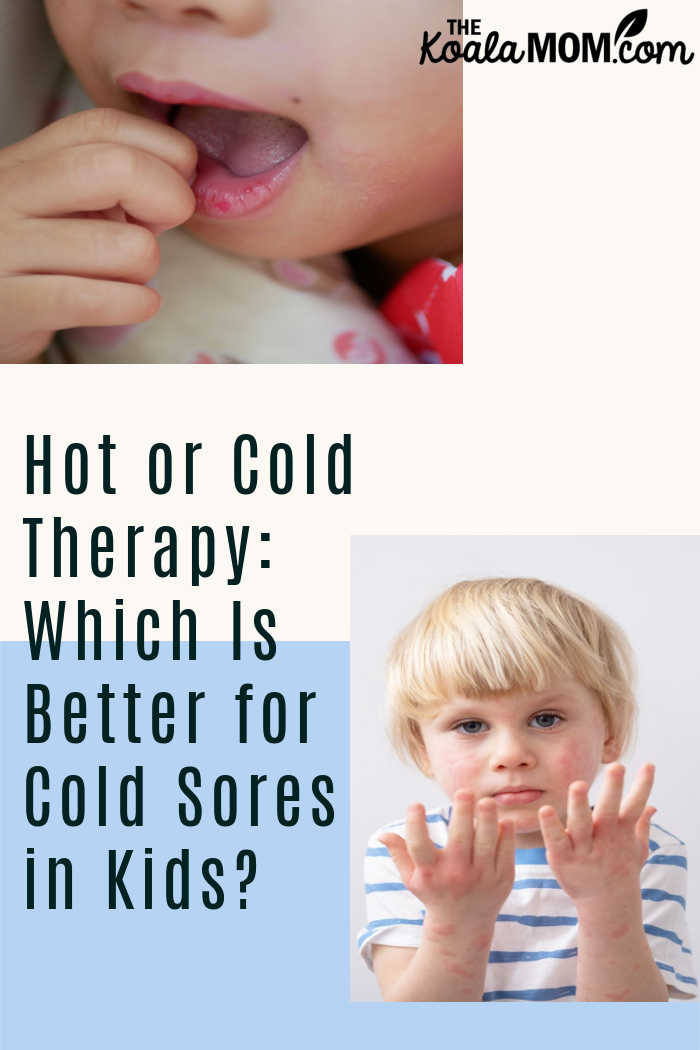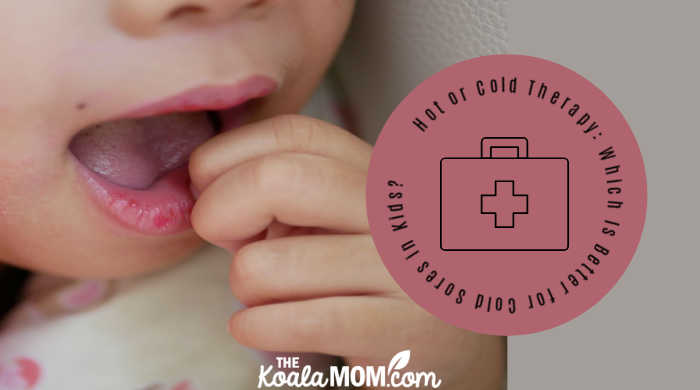Treating your kid’s cold sores at home through a hot or cold compress is common. Cold sores usually subside on their own after a few days. However, it may cause severe discomfort for those few days, particularly in younger children.
Specific strains of the herpes simplex virus cause cold sores. It’s common in kids and toddlers with a weakened immune system, increased emotional tension, or exposure to direct sunlight. Some consider hot therapy to be effective in easing discomfort, while some prefer cold therapy as it numbs the pain. Here are some points to find out which is better.

Cold Therapy
Ice packs are commonly used for different types of skin inflammation. The cold temperature decelerates the blood flow, which is good for reducing pain. 1001 Natural Remedies notes, “If you feel the tingling sensation of an impending herpes outbreak, rub an ice cube on the area. This sometimes stops a cold sore from erupting.” Of course, kids don’t always tell us (or we may not be sure what they are complaining about if we can’t see something), so this isn’t always effective.
Once the cold sore has emerged, cold therapy may still help reduce the effects of the cold sore. Some types of cold therapy are the following:
- Cold Compress
Applying a cold compress to the affected area may ease discomfort in children. It helps reduce redness and swelling due to cold sores and other skin inflammation. To do this, you may soak a washcloth in ice water and gently dab it on the sores. It’s not recommended to apply ice directly since children’s skin is more sensitive. For other safe methods, you can get more tips here.
- Cryotherapy
Cryotherapy is an effective method for cold sores. Liquid nitrogen freezes the blisters, giving visible results within 24 to 48 hours. However, one must not try this at home. It’s best to consult your pediatrician for the best and safest treatment for your young one, but if your child is particularly upset or fussy about the cold sore, then getting the help of your care provider is worth it.
Advantages and Disadvantages of Cold Therapy
It’s undeniably true that a cold sore can be very painful, especially for kids. To help ease the pain your child is experiencing, consider applying cold therapy. There are some advantages and disadvantages to applying cold therapy for cold sores.
Advantages:
- Cold therapy numbs the pain. Ice is used to treat several types of injuries and inflammations to numb the pain and itchiness. Kids will most likely scratch or pick the blisters, which can worsen the condition. If your kid gets uncomfortable with a cold compress, you can give them a cold or icy treat like popsicles.
- It reduces swelling. Cold therapy decreases blood circulation in the affected area. Constricting the blood vessels reduces swelling and inflammation, which may cause severe discomfort. Since young kids and toddlers can be more susceptible to pain, focusing on relieving the inflammation should be prioritized.
- Cold therapy dries the blisters. Cryotherapy is the fastest way to dry blisters from cold sores. The liquid nitrogen freezes the sores from its core, which stops them from spreading. It’s recommended for school-age kids and older or those who can tolerate cold sensations around the mouth. This method needs medical monitoring with the help of medical experts. So it’s best to consult your doctor about this treatment.
Disadvantages
- There’s a risk of ice burn. Extreme cold can cause further skin irritations, especially in kids. Don’t use ice directly on the skin to avoid this issue. You may use an ice pack wrapped in a soft towel or washcloth to prevent ice burn from cold compresses.
- Cryotherapy requires medical supervision. It may thus take more time to treat (as you need to book an appointment with your care provider).
Hot Therapy
Hot therapy or heated / warm treatment is also a common home remedy for cold sores. The heat may help ease discomfort and reduce itchiness due to several skin conditions. Is it effective for cold sores?
Using a hot compress can reduce pain from cold sores. It’s an alternative for kids who can’t handle cold compress or ice packs. It brings coziness, especially if your kid is struggling to fall asleep due to severe discomfort caused by a cold sore.
Before using this method to your kids, it’s good to know the advantages and disadvantages this method can offer:
Advantages
- Quickens Healing Process
Hot therapy may reduce inflammation for those who are already recovering. The heat encourages better blood flow, which can quicken the healing process. However, it’s best to note its effect on the skin. If swelling persists, consult your pediatrician.
- Eases Discomfort
A hot compress can provide short-term relief for children, especially during cold nights. It’s best to use it while on prescribed medications to maximize comfort. Doing so will eliminate the risk of making the condition worse.
Disadvantages
- Minimal Results
Unlike cold compress, hot therapy may only give short-term comfort and minimal results. It can make your kid feel cozy, but the proof of hot compress treating cold sores is insufficient. It’s why it’s best to consult a doctor before trying it on your kid’s sensitive skin.
- May Increase Redness
In some cases, a hot compress can only increase redness. It might help reduce the swelling, but the skin may still get irritated, especially with excessive heat. Before using a hot compress on children, it’s best to check the temperature by touching it with the back of your hand to know if it’s too hot.

Combining Treatment Options
Combining hot or cold therapy with other methods of treating cold sores may be the most effective. For example, start with cold therapy before or as soon as the cold sore emerges. 1001 Natural Remedies recommends applying calendula and diluted tea tree oil to the cold sore. Make a strong tea of calendula and then freeze it in ice cubes or keep it in the fridge and dab it on the cold sores. As the cold sore retreats, warm therapy may be effective to help kids not pick at it as much.
If the cold sore doesn’t heal in a few days or seems to be causing extreme discomfort for your child, it’s always best to seek the advice of your doctor. Some kids may be more prone to cold sores or may react more to them than other kids. Treating the cold sores may be a process of trial and error to see what’s effective but hopefully these tips will give you a place to start.
Which Is Better?
Based on visible results, cold therapy or cryotherapy is the fastest treatment method for children’s cold sores. Cold temperature freezes the blisters and dries them off quickly. Moreover, a cold compress is more effective in reducing inflammation and redness than a hot compress.
Determining which is better between hot and cold therapy depends on each case. Hot treatment would be suitable if your kid is already taking prescribed medication and only needs comfort and coziness to sleep. On the other hand, cold therapy, whether using a cold compress or going to the doctor for cryotherapy, is efficient for stopping the spread of blisters.

No Responses Yet